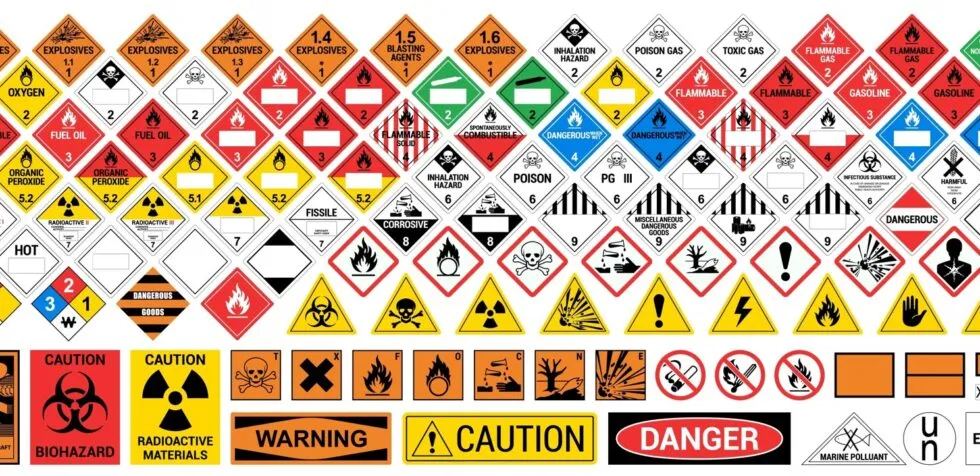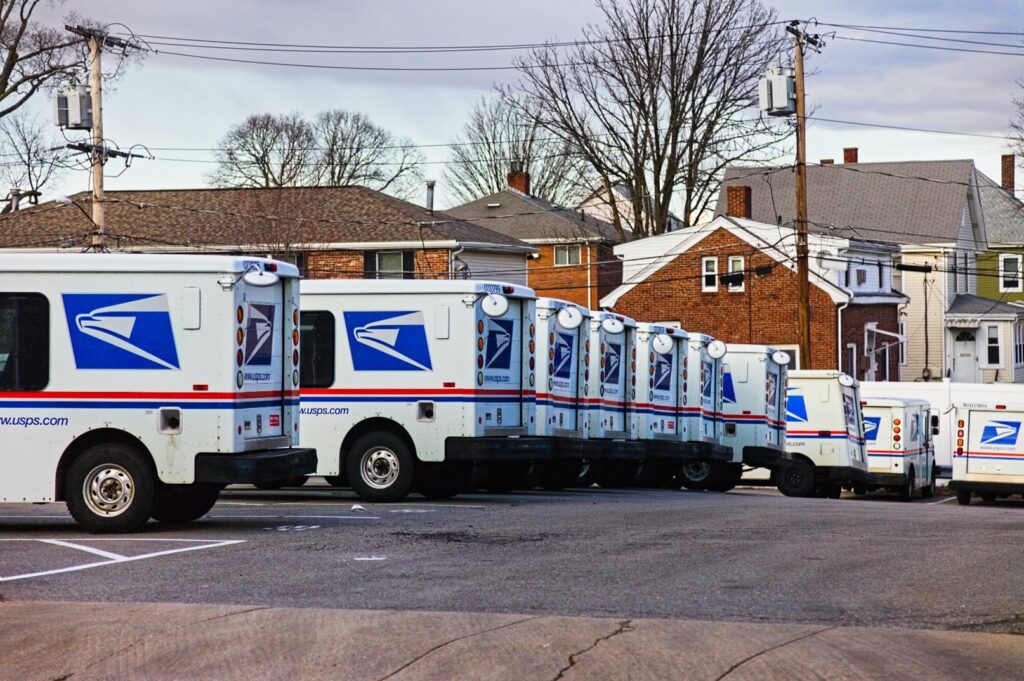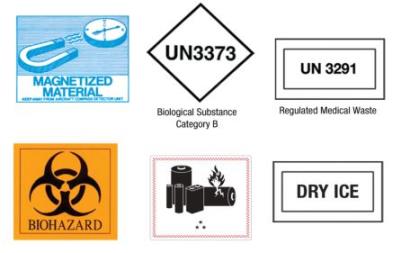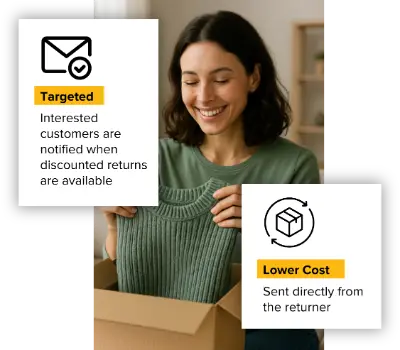USPS Hazmat Shipping Guidelines – How to Ship Fast While Staying Compliant

Last updated on February 27, 2025

In this article
 24 minutes
24 minutes
- Understanding Hazardous Materials Regulations
- What is a Hazardous Material?
- What Items Are HAZMAT?
- Classes of HAZMAT Items
- What Classes Can Ship Using USPS Services?
- What Changes Have USPS Recently Made to Hazardous Materials Regulations?
- Why Have These Changes Been Made?
- What Should You and Your 3PL Do While Shipping HAZMAT?
- Declare HAZMAT During Label Generation
- Additional Resources and Support
- Conclusion
- Frequently Asked Questions
Understanding Hazardous Materials Regulations
Navigating the landscape of hazardous materials regulations is crucial for ensuring the safe and secure transportation of these potentially dangerous goods. These regulations are meticulously designed to prevent accidents, injuries, and environmental damage during the transportation process.
In the United States, the Department of Transportation (DOT) plays a pivotal role in regulating the transportation of hazardous materials. The DOT’s Hazardous Materials Regulations (HMR), found in Title 49 of the Code of Federal Regulations, outline comprehensive guidelines for the classification, packaging, and labeling of hazardous materials. These regulations ensure that hazardous materials are properly identified and handled with the utmost care.
The HMR mandates that hazardous materials must be accurately classified, appropriately packaged, and clearly labeled before transportation. Additionally, individuals involved in handling these materials are required to undergo proper training to adhere to established safety procedures. This training is essential for minimizing risks and ensuring compliance with regulatory standards.
Beyond the DOT, other regulatory bodies also contribute to the safe handling of hazardous materials. The Occupational Safety and Health Administration (OSHA) enforces regulations that govern the handling of hazardous materials in the workplace, ensuring the safety of employees. The Environmental Protection Agency (EPA) oversees the transportation of hazardous waste, further safeguarding public health and the environment.
By adhering to these regulations, individuals and organizations can significantly reduce the risk of accidents and injuries, while also protecting the environment. Compliance with hazardous materials regulations is not just a legal obligation but a critical component of responsible and safe transportation practices.
What is a Hazardous Material?
For many ecommerce brands and sellers, there are already lots to think about when shipping orders – you need to send inventory to warehouses, have shipping labels printed, and pick, pack and ship items correctly.
However, some sellers sell products that require extra diligence, care, and attention while shipping them. Shipping Hazardous Materials, or HAZMAT as they’re commonly called, can be complex. In January 2025, the United States Postal Service (USPS) announced a number of changes to the guidelines sellers have to follow while shipping HAZMAT items. Following these guidelines is important for sellers to maintain compliance and mitigate regulatory risks, while also ensuring the safety of USPS staff who ship and deliver your packages.
A lot of sellers may not be aware of the extent and impact of these new changes. Failing to comply with the new requirements can cause significant damage to your brand. In this article, we’ve compiled everything you need to know about HAZMAT shipping.
We start by understanding the definition of a hazardous material and what items are classified as HAZMAT. We then take a deep-dive into how the Postal Service was handling HAZMAT previously and what has changed in the latest requirements. We examine why the USPS might be making these changes and the potential penalties you face for non-compliance. Lastly, we look at what your fulfillment partner (3PL) must do to ship hazmat orders in a compliant manner, keeping your brand, USPS personnel, and your customers safe.
What Items Are HAZMAT?
The Postal Service classifies every hazardous material into one of nine categories.
Common hazardous materials that are regulated include:
- Combustible liquids
- Hazardous substances
- Lithium batteries
- Lithium ion batteries
- Hazardous waste
- Hazardous wastes
- Common hazardous materials
Proper packaging of hazardous materials packages is crucial to ensure compliance with safety standards and prevent leaks or spills during shipping.
Let AI Optimize Your Shipping and Boost Profits
Cahoot.ai software selects the best shipping option for every order—saving you time and money automatically. No Human Required.
See AI in ActionClasses of HAZMAT Items
Let’s first examine these categories, understanding their definitions, example items that fall into them, and the risks they can pose to people, the environment, or property.
You can use this as a template to do a preliminary analysis of whether your items are likely to fall into any of these HAZMAT categories. Proper classification and packaging are essential for shipping dangerous goods safely and in compliance with regulations. Packages that do not meet HAZMAT regulations can be held and delayed, destroyed by the postal service, or result in fines.
Hazard Class |
Definition |
Example Items |
Risks |
|---|---|---|---|
1.1 – 1.6 |
Explosives with varying characteristics |
Fireworks, dynamite, and ammunition (small arms) |
Can vary from a massive explosion to low sensitivity explosions. |
2.1 |
Flammable Gasses |
Lighter fluid, Propane, and Butane |
Fire hazards and explosion risks |
2.2 |
Non-Flammable, Non-Toxic Gasses |
Nitrogen (for tires), Carbon Dioxide (fire extinguisher) |
No fire hazard, asphyxiation risk |
2.3 |
Toxic Gasses |
Household Cleaners (Ammonia), Bleach |
Toxic inhalation hazard |
3 |
Flammable Liquids |
Gasoline, Rubbing Alcohol, Lighter Fluid |
Fire hazard |
4.1 |
Flammable Solids |
Matches, Lighter Cubes, Firestarters |
Fire hazard, may contribute to combustion |
4.2 |
Spontaneously Combustible Solids |
Spontaneous Combustion Firestarters |
Can ignite spontaneously |
4.3 |
Dangerous When Wet |
Fertilizers (contains Ammonium Nitrate), Sodium (in water) |
Can release flammable gas when in contact |
5.1 |
Oxidizing Substances |
Hydrogen Peroxide (in hair bleach), Nitric Acid (in fertilizers) |
Enhances combustion, fire risk |
5.2 |
Organic Peroxides |
Acne Creams (Benzoyl Peroxide), Hair Bleaching Kits (contains peroxide) |
Fire and explosion risk |
6.1 |
Toxic Substances |
Pesticides (e.g., Insecticides), Household Cleaners (contains toxins) |
Toxic to humans |
6.2 |
Infectious Substances |
Medical Waste, Biological Cultures (e.g., from labs) |
Risk of spreading diseases |
7 |
Radioactive Materials |
Smoke Detectors (contains Americium), X-ray Machines (used in medical facilities) |
Ionizing radiation hazard |
8 |
Corrosive Substances |
Drain Cleaner (contains Sulfuric Acid), Alkaline Batteries |
Corrosive to materials, skin, eyes |
9 |
Miscellaneous Hazardous Materials |
Lithium Batteries (found in electronics), Asbestos-containing Materials |
Various hazards depending on the material |
What Classes Can Ship Using USPS Services?
Based on the class of item your product falls into, it may or may not be allowed on Ground or Air services in the US or International shipping.
You can use this as a resource to understand whether your item is allowed to ship, and what services it can be sent through.
Ensure that each package is labeled with the proper shipping identification to comply with USPS regulations.
Substantial portions of this chart are based on Publication 52 – Hazardous, Restricted and Perishable Mail from the USPS.
For more information on a specific hazard class or regulation, refer to Publication 52. For help with a specific SKU you’re trying to ship, refer to the Postal Service’s HAZMAT Shipping tool.
Items |
Ground |
Air |
International |
|---|---|---|---|
Explosives With Varying Characteristics (1.1 to 1.6) |
Prohibited Class 1.4 (Minor Explosion Hazard) may be shipped, only with prior approval from USPS Headquarters as per 341.2c of Publication 52 |
Prohibited |
Prohibited |
Flammable Gasses (2.1) |
Only as Limited Quantity Surface Material, per 342 of Publication 52 |
Prohibited |
Prohibited |
Non-Flammable, Non-Toxic Gasses (2.2) |
Only as Limited Quantity Surface Material, per 342 |
Permitted if material qualifies as ID8000, per 342 |
Prohibited |
Toxic Gasses (2.3) |
Prohibited |
Prohibited |
Prohibited |
Flammable Liquids (3) |
Only as Limited Quantity Surface Material, per 343 |
Prohibited Combustible liquids are permitted if material qualifies as ID8000 per 343 |
Prohibited |
Flammable Solids (4.1) |
Only as Limited Quantity Surface Material, per 344 |
Prohibited |
Prohibited |
Spontaneously Combustible Solids (4.2) |
Only as Limited Quantity Surface Material, per 344 |
Prohibited |
Prohibited |
Dangerous When Wet (4.3) |
Only as Limited Quantity Surface Material, per 344 |
Prohibited |
Prohibited |
Oxidizing Substances (5.1) |
Only as Limited Quantity Surface Material, per 345 |
Only as Limited Quantity Air Material, per 345 |
Prohibited |
Organic Peroxides (5.2) |
Only as Limited Quantity Surface Material, per 345 |
Only as Limited Quantity Air Material, per 345 |
Prohibited |
Toxic Substances (6.1) |
Only as Limited Quantity Surface material per 346. Other poisons may ship as permitted in 346.231 |
Permitted if it qualifies as ID8000 material per 346. Other poisons may ship as permitted in 346.231 |
Prohibited |
Infectious Substances (6.2) |
Only as permitted in 346 |
Only as permitted in 346 |
Only First-Class Package International Service with Registered Mail service per 622 |
Radioactive materials (7) |
Only per 347 |
Prohibited |
Only First-Class Package International Service with Registered Mail service per 622 |
Corrosive Substances (8) |
Only Limited Quantity Surface material per 348 |
Only Limited Quantity Air material per 348 |
Prohibited |
Miscellaneous Hazardous Materials (9) |
Only Limited Quantity Surface material and other materials as permitted in 349 |
ID8000 material and other materials as permitted in 349 |
Prohibited, except for magnetized materials per 349 and 622.4 and lithium batteries per 622.5 |
ShipStation vs. Cahoot: 21x Faster, Real Results
Get the inside scoop on how a leading merchant switched from ShipStation to Cahoot—and what happened next. See it to believe it!
See the 21x DifferenceWhat Changes Have USPS Recently Made to Hazardous Materials Regulations?
Recently, the USPS has been making a number of changes to the way it handles and processes HAZMAT shipping.
These have important implications for sellers. In this section, we take a look at each of them:
Declaring HAZMAT During Label Generation
USPS now requires shippers to officially declare that packages contain HAZMAT when they purchase shipping labels.
The shipping label consequently clearly indicates this, making it easy for USPS staff to handle the shipment with the required care. Proper documentation is essential for transporting hazardous materials safely and in compliance with regulations.
Items Allowed on Ground vs. Air
Recently, USPS has begun restricting electronic devices that are used, damaged, or defective to ground services alone.
These packages must now be labeled as ‘Restrictive Electronic Devices’ for ‘Surface Transportation Only’.
Separation of HAZMAT And Non-HAZMAT Items
The USPS has also begun requiring that HAZMAT and non-HAZMAT items must be clearly separated into different parcels or mail receptacles. The HAZMAT parcels need to have clear marking and identification.
Why Have These Changes Been Made?
Why is there suddenly an increased focus on these compliance requirements from the Postal Service? Many shippers have been used to operating without any changes to requirements for a long time and might be surprised about why these changes are taking place now.
In this section, we’ll take a look at why USPS is enforcing these new requirements, as well as the risks you face if you don’t comply with them.
Safety of USPS Personnel and Transportation

According to Shippo’s estimates, over 10,000 safety incidents involving HAZMAT shipping were reported in the first nine months of the 2020 fiscal year. That number has continued rising – in 2022, there were over 25,000 HAZMAT incidents reported.
Such incidents pose significant risks for USPS personnel, the environment, property, and other people sharing the road or airspace during their transportation. In a bid to reduce this impact and improve overall safety outcomes, these new requirements are being enforced.
More Reliable On-Time Delivery
While these incidents are detrimental from a health and safety perspective, that isn’t their only negative. They disrupt operations and delay deliveries. In fact, Shippo estimates that packages are delayed by an average of 2 weeks after such incidents.
With USPS aiming to compete more aggressively in parcel delivery with the likes of UPS and FedEx, an increasing accident rate can lower their delivery SLAs and affect service levels for all shippers.
USPS’ latest regulations are aimed at streamlining their network operations and reducing downtime and disruptions.
Penalties For Non-Compliance
As the number of HAZMAT shipping related incidents is on the rise, failure to comply could affect your brand’s ability to conduct operations normally. With health, safety, and lives at stake – the penalties for noncompliance are heavy. Here are the possible penalties:
- Your shipments could be denied entry into the USPS mailstream – affecting your ability to meet customer delivery promises.
- For serious infractions, the US Department of Transportation can pursue civil penalties.
- The maximum penalty for Hazardous Materials violation is $89,678. However, if the violation results in death, serious illness, severe injury to an individual or significant damage to property, you could be fined as much as $209,249.
Such incidents can be financially damaging, affect your brand’s reputation and in some cases even threaten its very existence.
What Should You and Your 3PL Do While Shipping HAZMAT?
The first question you might have is – which of my SKUs are HAZMAT? The quickest way to identify this is using the Product Safety Data Sheet (SDS). What is a Safety Data Sheet?
Identify Your HAZMAT SKUs Using Product Safety Data Sheets (SDS)
A Safety Data Sheet (SDS) is a document that provides detailed information about the properties, hazards, and safe handling procedures of a product. It includes essential details such as the product’s composition, physical and chemical characteristics, potential health and environmental hazards, safe usage guidelines, emergency response measures, and regulatory information.
You can use the SDS database to locate your product’s safety sheet.
On it, you’ll need to go to Section 14, which provides transportation information, including the category that DOT classifies the product under. Using this, you can understand which USPS services can be used to ship the item, as well as specific marking/labeling, and packaging requirements.
Properly Designate HAZMAT SKUs on Shipping Software
You need to designate your HAZMAT SKUs on your shipping software. This is important for a number of reasons:
- This can be transmitted to USPS when purchasing labels, so that they know you are shipping HAZMAT.
- It helps your fulfillment partner affix the right marking/labels when packing these items.
- It helps your fulfillment partner package these items the right way.
Having your SKUs properly designated on a digital system of record is the best way to ensure defect-free, compliant fulfillment. Relying on spreadsheets or human-to-human conversation can lead to potentially costly lapses.
Adhere to Packaging Requirements

While shipping HAZMAT, you must make sure to follow packaging requirements to keep your items secure and spill or leak-proof.
Your fulfillment partner must have deep knowledge of what HAZMAT SKUs you are shipping, and then package them in accordance with the specific requirements laid out in Appendix C of Publication 52.
While the details can vary significantly based on the item, these are broad best-practice guidelines applicable across most items. Following these packaging practices requires industry-leading fulfillment standards from your 3PL. Warehouse staff must make sure to diligently pack each SKU in the best possible way on every order.
Inner Packaging
- Employ inner packaging that is compatible with the specific hazardous material but also capable of withstanding the conditions of transportation.
- Inner packaging must be leak-tight for liquids and gas-tight for gasses, preventing unintended release during transit.
Outer Packaging
- Utilize robust outer packaging that serves as a primary barrier to protect the inner packaging and the contents from external forces and potential hazards.
- All HAZMAT and Dangerous Goods need to ship in rigid outer packaging that meets minimum edge crust test (ECT) requirements:
- Packages weighing 20 lbs or less: ECT of at least 32, burst strength of 200 lbs.
- Packages weighing more than 20 lbs: ECT of at least 44, burst strength of 275 lbs.
- Choose outer packaging materials that are suitable for the specific characteristics of the hazardous material being shipped.
Cushioning and Absorption
- An effective cushioning system safeguards the inner packaging from movement and potential damage during transit, providing an additional layer of protection.
- For liquids, incorporate absorbent materials within the packaging to contain and manage spills, preventing leakage that could pose safety and environmental risks.
Closure and Sealing
- Ensure secure closure and sealing of packages to prevent any leakage or spillage during transportation.
- Verify that closures meet regulatory standards and are appropriate for the specific hazardous material being shipped, maintaining the integrity of the package.
Overpack Requirements
- If applicable, employ overpacking techniques as an additional layer of protection and consolidation for smaller packages.
- Overpacks should not only consolidate packages but also be designed to contain leaks or spills, providing an extra measure of safety.
Separation of HAZMAT
- Package hazardous materials with a keen focus on preventing any reactions between different substances within the package.
- Separation of incompatible materials within the packaging ensures that any potential chemical reactions are avoided, maintaining the safety and stability of the shipment.
Quantity Limits
- Adhere strictly to quantity limits specified for each hazardous material to prevent overloading and ensure compliance with safety regulations.
- Packaging must be designed to accommodate the specified quantity, preventing any compromise in the safety of the contents.
Adhere to Marking and Labeling Requirements
When shipping HAZMAT items, it is important to affix various marking labels onto the package that provide information to USPS staff about what the package contains.
This helps them handle the package the right way and ensures higher safety standards. While these can vary significantly by product, here are a few common marking/labeling practices required for HAZMAT items. For your specific SKU, make sure to refer to Appendix C of Publication 52.
Your 3PL must be capable of mapping each SKU you have to its specific labeling requirements. This detail-oriented rigor must be backed up by defect-free, high-quality fulfillment standards that ensure each package has all the necessary labels on it.
- Hazard Class Labels
- Hazard class labels need to be affixed to the outer packaging, indicating the primary hazard class or division of the material.
- Ensure hazard class labels are prominently displayed, providing USPS staff a quick visual identification of the potential risks associated with the shipment.
- Handling Labels
- Mark packages with handling labels, communicating specific instructions on how to safely handle them during transportation.
- Clear and concise handling labels contribute to the safe and proper management of the package during transit.
- Identification Numbers
- Clearly display proper shipping names and identification numbers on the outer packaging.
- This information assists in identifying the material and its associated hazards, aiding in emergency response and handling procedures.
- Limited Quantity Marking
- If applicable, mark packages with the “Limited Quantity” marking to indicate compliance with quantity limitations for certain hazardous materials.
- This marking is crucial for packages that qualify for reduced regulatory requirements.
- Overpack Marking
- For overpacks, mark them appropriately to indicate that they contain hazardous materials.
- Overpack markings help handlers and emergency responders quickly identify packages that include multiple smaller packages.
- Orientation Arrows
- On packages containing liquids, include orientation arrows to indicate the correct orientation for safe handling.
- Proper orientation ensures that liquids are transported in a manner that minimizes the risk of leaks or spills.
- Elevated Temperature Marking
- If applicable, mark packages containing materials at elevated temperatures to communicate the additional risks associated with heat.
- This marking ensures awareness of temperature-related hazards during transportation.
Declare HAZMAT During Label Generation

If you’ve designated your SKUs as HAZMAT in your shipping software, this step shouldn’t be too difficult!
When generating labels, your shipping software needs to inform USPS that you’re shipping HAZMAT. This allows the Postal Service to prepare to handle your items the right way.
Cut Costs with the Smartest Shipping On the Market
Guranteed Savings on EVERY shipment with Cahoot's AI-powered rate shopping and humanless label generation. Even for your complex orders.
Cut Costs TodayAdditional Resources and Support
Ensuring compliance with hazardous materials regulations can be a complex task, but fortunately, there are numerous resources available to assist individuals and organizations. These resources provide valuable information, guidelines, and support to help navigate the regulatory landscape effectively.
Key resources include:
- Department of Transportation’s (DOT) Hazardous Materials Regulations (HMR): The primary source for regulations governing the transportation of hazardous materials.
- Occupational Safety and Health Administration’s (OSHA) Hazardous Materials Regulations: Guidelines for handling hazardous materials in the workplace.
- Environmental Protection Agency’s (EPA) Hazardous Waste Regulations: Regulations specifically focused on the transportation of hazardous waste.
- International Air Transport Association’s (IATA) Dangerous Goods Regulations: Guidelines for the safe transportation of dangerous goods by air.
- International Maritime Organization’s (IMO) Dangerous Goods Regulations: Regulations for the safe transportation of dangerous goods by sea.
- Federal Regulations Hazardous Materials Table: A comprehensive resource providing information on the classification, packaging, and labeling of hazardous materials.
- Safety Data Sheet (SDS): Detailed documents for a SKU that provide information on the safe handling and use of hazardous materials. Obtained from the manufacturer.
- Material Safety Data Sheet (MSDS): Similar to SDS, these sheets offer information on the safe handling and use of hazardous materials. Obtained from the manufacturer.
- Hazardous Materials Information Center: A resource center providing information and support on hazardous materials regulations and safety procedures.
- National Institute for Occupational Safety and Health (NIOSH): Offers information and resources on workplace safety and health, including hazardous materials safety.
- American Society of Safety Professionals (ASSP): Provides resources on workplace safety and health, including hazardous materials safety.
In addition to these resources, various organizations and companies offer training and consulting services to help ensure compliance with hazardous materials regulations. These services are invaluable for individuals and organizations looking to enhance their understanding of regulatory requirements and implement effective safety procedures.
Staying up to date with the latest regulations and utilizing available resources is essential for maintaining compliance and ensuring the safe transportation of hazardous materials. By leveraging these resources, individuals and organizations can effectively manage the complexities of hazardous materials regulations and contribute to a safer transportation environment.
Conclusion
With an increased focus on the safety of its personnel and the performance of its network, USPS has rolled out these new HAZMAT changes.
Many, many items fall under HAZMAT, and a lot of them may not be immediately obvious as meeting the classification. With increased penalties and regulations, it is important for shippers to carefully scan their product catalog for HAZMAT SKUs and then ship them following all necessary protocols.
This takes deep attention to detail, high quality fulfillment standards, and solid technology at your fulfillment partner’s end. Shipping HAZMAT items can seem daunting – but with the right fulfillment partner, you’ll be able to ship them as seamlessly as your other SKUs. Good luck, and happy shipping!
Frequently Asked Questions
What are the Risks of Not Shipping HAZMAT Correctly?
Improperly labeled packages can be delayed or destroyed by the post office. Your business may also be fined for violations, and penalties up to $209,249.00 can occur if the HAZMAT violation results in death, serious injury or property destruction.
Do HAZMAT Rules Apply to All Shipping Carriers?
Each shipping carrier has its own rules and regulations for shipping HAZMAT goods. USPS rules and regulations do not apply to UPS or FedEx.
How Can I Tell if an Item is Considered HAZMAT?
Always make sure! Check the product’s Safety Data Sheet (SDS) from the manufacturer or use a HAZMAT search tool.

Turn Returns Into New Revenue


